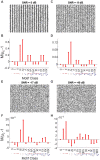Third-order motifs are sufficient to fully and uniquely characterize spatiotemporal neural network activity
- PMID: 36604489
- PMCID: PMC9816122
- DOI: 10.1038/s41598-022-27188-6
Third-order motifs are sufficient to fully and uniquely characterize spatiotemporal neural network activity
Abstract
Neuroscientific analyses balance between capturing the brain's complexity and expressing that complexity in meaningful and understandable ways. Here we present a novel approach that fully characterizes neural network activity and does so by uniquely transforming raw signals into easily interpretable and biologically relevant metrics of network behavior. We first prove that third-order (triple) correlation describes network activity in its entirety using the triple correlation uniqueness theorem. Triple correlation quantifies the relationships among three events separated by spatial and temporal lags, which are triplet motifs. Classifying these motifs by their event sequencing leads to fourteen qualitatively distinct motif classes that embody well-studied network behaviors including synchrony, feedback, feedforward, convergence, and divergence. Within these motif classes, the summed triple correlations provide novel metrics of network behavior, as well as being inclusive of commonly used analyses. We demonstrate the power of this approach on a range of networks with increasingly obscured signals, from ideal noiseless simulations to noisy experimental data. This approach can be easily applied to any recording modality, so existing neural datasets are ripe for reanalysis. Triple correlation is an accessible signal processing tool with a solid theoretical foundation capable of revealing previously elusive information within recordings of neural networks.
© 2023. The Author(s).
Conflict of interest statement
The authors declare no competing interests.
Figures






Similar articles
-
Third-order entropy for spatiotemporal neural network characterization.J Neurophysiol. 2025 Apr 1;133(4):1234-1244. doi: 10.1152/jn.00108.2024. Epub 2025 Mar 17. J Neurophysiol. 2025. PMID: 40098383
-
A Novel Quantitative Metric Based on a Complete and Unique Characterization of Neural Network Activity: 4D Shannon's Entropy.bioRxiv [Preprint]. 2023 Sep 15:2023.09.15.557974. doi: 10.1101/2023.09.15.557974. bioRxiv. 2023. PMID: 37745513 Free PMC article. Preprint.
-
The uniqueness theorem for complex-valued neural networks with threshold parameters and the redundancy of the parameters.Int J Neural Syst. 2008 Apr;18(2):123-34. doi: 10.1142/S0129065708001439. Int J Neural Syst. 2008. PMID: 18452246
-
Application of Neural Networks for classification of Patau, Edwards, Down, Turner and Klinefelter Syndrome based on first trimester maternal serum screening data, ultrasonographic findings and patient demographics.BMC Med Genomics. 2018 Feb 13;11(1):19. doi: 10.1186/s12920-018-0333-2. BMC Med Genomics. 2018. PMID: 29439729 Free PMC article.
-
Techniques to identify and temporally correlate calcium transients between multiple regions of interest in vertebrate neural circuits.J Neurophysiol. 2017 Mar 1;117(3):885-902. doi: 10.1152/jn.00648.2016. Epub 2016 Nov 30. J Neurophysiol. 2017. PMID: 27903638 Free PMC article.
Cited by
-
Temporal resolution of spike coding in feedforward networks with signal convergence and divergence.PLoS Comput Biol. 2025 Apr 21;21(4):e1012971. doi: 10.1371/journal.pcbi.1012971. eCollection 2025 Apr. PLoS Comput Biol. 2025. PMID: 40258062 Free PMC article.
-
Temporal resolution of spike coding in feedforward networks with signal convergence and divergence.bioRxiv [Preprint]. 2024 Oct 28:2024.07.08.602598. doi: 10.1101/2024.07.08.602598. bioRxiv. 2024. Update in: PLoS Comput Biol. 2025 Apr 21;21(4):e1012971. doi: 10.1371/journal.pcbi.1012971. PMID: 39026834 Free PMC article. Updated. Preprint.
References
Publication types
MeSH terms
Grants and funding
LinkOut - more resources
Full Text Sources

